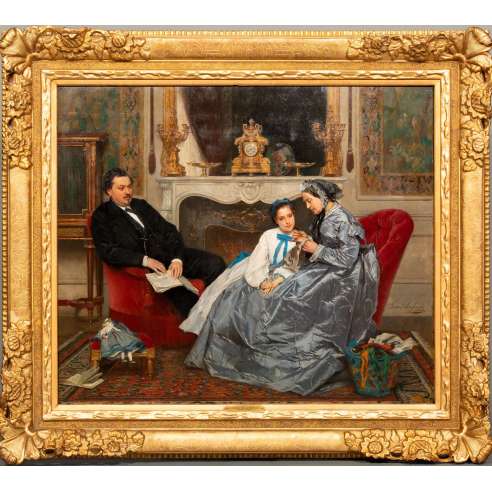"The Embroidery Lesson" is a masterful representation of Gustave De Jonghe’s ability to capture the elegance and intimacy of domestic life. Through his sophisticated use of color, meticulous brushwork, and keen attention to detail, De Jonghe creates a scene that is both realistic and emotionally resonant, celebrating the warmth of familial bonds and the transmission of tradition across generations.
"The Embroidery Lesson" by Gustave De Jonghe is an intimate and carefully composed domestic interior scene. The painting features three figures: a man, a young girl, and an elderly woman, who is the girl’s grandmother. The grandmother and the girl sit closely together on a richly upholstered sofa, engaged in an embroidery lesson. The grandmother’s attentive posture and the young girl’s focus suggest a moment of shared learning and connection across generations. Meanwhile, the man, likely the girl's father, is seated in a plush red armchair on the left side of the composition, holding a paper or book. He observes the lesson with a relaxed demeanor, adding to the calm, familial atmosphere.
In the foreground, a doll is placed on a small chair, and a basket filled with colorful threads and fabrics sits beside the grandmother, emphasizing the domestic and nurturing environment. These elements not only add detail to the scene but also highlight the educational aspect of the grandmother’s role in passing down skills to the next generation. The background features an ornate fireplace, adding warmth and depth to the setting. The fireplace is decorated with an intricate clock and candelabras, further enhancing the luxuriousness of the interior. The rich decor, including the patterned carpet and wall coverings, reflects the affluence of the family.
De Jonghe utilizes a rich and harmonious color palette, with deep reds, cool blues, and soft grays dominating the scene. The red of the armchairs and the warm tones of the carpet provide a striking contrast to the cool, silvery-blue hues of the grandmother and granddaughter’s dresses, creating a visually balanced composition. The light is soft and natural, likely coming from an unseen window. It gently illuminates the figures, particularly highlighting the textures of the luxurious fabrics and the warmth of the setting. The interplay of light and shadow adds depth to the scene, enhancing the realism of the painting.
De Jonghe's brushwork is precise and meticulous, especially in the rendering of the satin fabrics and the intricate details of the interior decor. The textures are beautifully captured, from the soft sheen of the satin dresses to the rich patterns of the carpet and upholstery. The painting is a fine example of realism, a style De Jonghe excelled in. The figures are depicted with lifelike accuracy, and the environment is rendered with great attention to detail, reflecting the opulence and comfort of the bourgeois lifestyle.
The painting tells a touching story of familial bonding and the transmission of skills across generations. The grandmother is patiently teaching her granddaughter the art of embroidery, a skill likely passed down through their family. The young girl’s attentive posture and the grandmother’s focused guidance highlight the importance of this intergenerational exchange. The painting exudes a warm, nurturing atmosphere. The calm expressions and gentle interaction between the grandmother and granddaughter convey a sense of love, care, and continuity. The father’s relaxed presence further underscores the peaceful and harmonious family life depicted.
Art Historical Context:
Gustave De Jonghe was known for his detailed and elegant depictions of bourgeois domestic life, often focusing on the roles and activities of women within the home. His works, including "The Embroidery Lesson," are influenced by and share thematic similarities with those of his contemporaries, such as Alfred Stevens and Auguste Toulmouche, who also explored the quiet, refined moments of domestic life.




















